
Stefan Strömsdörfer

 |
Stefan Strömsdörfer |
 |
 Die dunkle Seite (Rätsel, Illusionen, Basteleien...)
Die dunkle Seite (Rätsel, Illusionen, Basteleien...)
Warum "die dunkle Seite"?
Zum einen wegen dem anderen Hintergrundbild, hauptsächlich aber
wegen der vielen sinnlosen Aktivitäten von mir, die mir wenig bringen,
aber trotzdem viel Zeit in Anspruch nehmen.
Ich kann hier leider nur eine sehr kleine Auswahl von Spielereien, die ich so betreibe und betrieben habe, auflisten. Das liegt u.a. am Platz, aber ich kann mich einfach nicht mehr an all den Mist erinnern, der mir während meines Lebens so eingefallen ist.
Zu den Illusionen gebe ich keine Erklärungen an, da ich womöglich noch irgendetwas falsches schreibe, wenn ich versuche, alles haargenau zu erklären. Ich denke man sollte sich darüber selber ein bißchen den Kopf zerbrechen (zur Not tut's auch eine mail, dann kann ich ja immer noch einen Erklärungsversuch starten).
Die Rätsel sind, wenn nicht anders gekennzeichnet, Denksportaufgaben (=Logikaufgaben). Es sind keine Probier-aufgaben (z.B. magische Quadrate) oder dumme Rechnereien (z.B: ich bin doppelt so alt wie die Quersumme des Alters von ... hoch der x-ten zahl des Alters von ... usw.).
Aber nun zu den essentiellen Dingen eines glücklichen Lebens:
 |
Geomtrische_Illusionen |
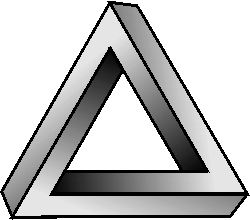
schiefes Dreieck

schiefes Quadrat
Das gleiche Prinzip wie beim Dreieck. Das Ganze läßt sich natürlich auf n-Ecke erweitern, ist dann aber nur noch langweilige Beschäftigungstherapie.

endlose Treppen
Eine meiner Leblingsillusionen, weil man damit beliebig komplizierte Figuren mit einer sehr großen Ausdehnung erstellen kann. Vor allem sehen die Treppen immer wieder anders aus. Das Ganze ist zwar nicht so professionell wie das endlos fließende Wasser von M.C.Escher, aber durchaus verwirrend genug, wenn man versucht, die Treppen gedanklich entlangzulaufen und dabei die "Stockwerke" mitzählt.
Hier noch eine andere, ziemlich bekannte Illusion:

 |
Optische_Täuschungen |
krumme Linien?
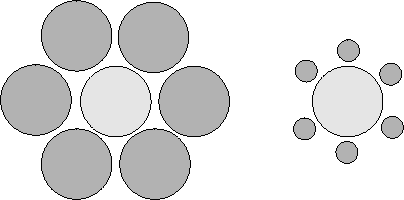
kleiner und großer Kreis?
Wer's nicht glaubt, kann die Durchmesser der hellen (inneren) Kreise nachmessen: auf's Pixel genau gleich groß!
Hier noch eine kleine Sammlung von anderen Optischen Täuschungen:
|
die waagrechten Linien sind wirklich waagrecht ! |

die schrägen Linien sind parallel |

die dunklen Schatten sind eine Illusion |
die Linie links ist "gerade",
|
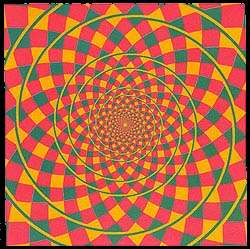 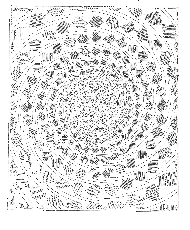
keine Spiralen, sondern Kreise ! |

die zwei Objekte sind gleich groß ! |
das ist ein Kreis ! |
|
 |
Denksportaufgaben |
 |
Basteln_von_geometrischen_Körpern |
Hier eine Übersicht inklusive 3D-Modelle!
Hier zuerst die Platonischen Körper:
Hier ein von mir entwickelter Körper auf Tetraederbasis (5.2 K)
Hier sind endlich die nichtkonvexen Körper:
Falls es jemanden interessiert, was eigentlich ein nichtkonvexer Körper
ist: Die anderen Körper sind stets nach außen gekrümmt
(=konvex), d.h. es gibt keine "Täler" auf ihrer Oberfläche. Bei
nichtkonvexen Körpern gibt es jedoch auch Talfalten.

5 verschachtelte Tetraeder
Dieser Körper ist der erste nichtkonvexe, den ich gebaut habe.
Das größte Hindernis dabei war, die genaue Form der einzelnen
Flächen auszurechnen. Dazu muss man sich über die Geometrie des
Körpers im klaren werden: er besteht aus 5 ineinandergeschachtelten
Tetraedern (siehe Bild), deren Ecken auf den Ecken eines Dodekaeders (siehe
oben) liegen. Da jedes Tetraeder 4 Ecken hat und das Dodekaeder 20, wird
keine Ecke doppelt belegt (5*4=20).Jetzt muss man natürlich zuerst
die Lage der Ecken eines Dodekaeders im dreidimensionalen Raum ausrechnen.
Das geht ohne große Probleme, wenn man mit dem richtigen Ansatz rangeht
(bei mir war der dritte Ansatz der halbwegs machbare). Ausreichend dafür
ist Schulmathematik (Sinussatz, Vektorrechnung, Geometrie...). Danach kann
man sich die Kanten- und Flächengleichungen aufstellen (natürlich
nur die, die zur Berechnung einer Fläche nötig sind).
Daraus erhält man durch Schnittpunkte die (dreidimensionalen) Koordinaten
der Eckpunkte einer Fläche, die man dann in zweidimensionale Koordinaten
umrechnen kann (ich habe einfach die Seitenlängen und Zwischenwinkel
ausgerechnet).
Die ganze Rechnerei habe ich nicht exakt, sondern mit dem Taschenrechner
auf ca. 4 Stellen genau durchgeführt. Das ist jedoch exakt genug,
da ich beim Basteln des Körpers keine Probleme bekommen habe (außerdem
kann man die Flächen sowieso nur mit begrenzter Genauigkeit ausschneiden).
Zum Basteln habe ich die 60 nötigen Elemente in 5 verschiedenen Farben
(mit Marmor-Füllmuster) bedruckt und somit die 5 Tetraeder hervorgehoben.
Hier kann man sich eine Grafik mit
Maßen anschauen. (Eigentlich gibt es noch eine zweite Version des
Körpers, wenn man die Fläche spiegelt)

2 verschachtelte Tetraeder
Dieser Körper ist eigentlich nur eine Vereinfachung des vorherigen, da hier zwei Tetraeder in einen Würfel einbeschrieben sind. Er ist natürlich viel einfacher zu bauen: nur 24 gleichseitige Dreiecke ausschneiden und aneinanderkleben.Ich habe leider noch keine Möglichkeit gefunden, 3, 4 oder mehr als 5 Tetraeder so in eine Kugel einzubeschreiben, so dass benachbarte Ecken gleiche Abstände haben und der resultierende Körper aus identischen Seitenflächen besteht.
 |
Witze_über_Mathematiker/Physiker/Ingenieure |
A topologist is a man who doesn't know the difference between a coffee cup and a doughnut.
A statistician can have his head in an oven and his feet in ice, and he will say that on the average he feels fine.
"Algebraic symbols are used when you do not know what you are talking about."
I saw the following scrawled on a math office blackboard
in college:
1 + 1 = 3, for large values
of 1
lim sqrt(8) ---> 3
8->9
lim sqrt (3) = 2
3->4
There are three kinds of people in the world; those who can count and those who can't.
A man camped in a national park, and noticed Mr.
Snake and Mrs. Snake slithering by. "Where are all the little snakes?"
he asked. Mr. Snake replied, "We are adders, so we cannot multiply."The
following year, the man returned to the same camping spot. This time
there were a whole batch of little snakes. "I thought you said you
could not multiply," he said to Mr. Snake. "Well, the park ranger
came by and built a log table, so now we can multiply by adding!"
If lim (8/x) = oo (infinity), then what does
lim (5/x) = ?
x->0
x->0
answer: (write 5 on it's side)
One day a farmer called up an engineer, a physicist, and a mathematican and asked them to fence of the largest possible area with the least amount of fence. The engineer made the fence in a circle and proclaimed that he had the most efficient design. The physicist made a long, straight line and proclaimed 'We can assume the length is infinite...' and pointed out that fencing off half of the Earth was certainly a more efficient way to do it. The Mathematician just laughed at them. He built a tiny fence around himself and said 'I declare myself to be on the outside.'
An engineer, a mathematician, and a computer programmer are driving down the road when the car they are in gets a flat tire. The engineer says that they should buy a new car. The mathematician says they should sell the old tire and buy a new one. The computer programmer says they should drive the car around the block and see if the tire fixes itself.
Math and Alcohol don't mix, so...
PLEASE DON'T DRINK AND DERIVE
An engineer thinks that his equations are an approximation
to reality.
A physicist thinks reality is an approximation to his equations.
A mathematician doesn't care.
Why is the number 10 afraid of seven?
-- because seven ate nine.
A mathematician is a person who says that, when 3 people are supposed to be in a room but 5 came out, 2 have to go in so the room gets empty...
A mathematician and a physicist agree to a psychological experiment. The mathematician is put in a chair in a large empty room and a beautiful naked woman is placed on a bed at the other end of the room. The psychologist explains, "You are to remain in your chair. Every five minutes, I will move your chair to a position halfway between its current location and the woman on the bed." The mathematician looks at the psychologist in disgust. "What? I'm not going to go through this. You know I'll never reach the bed!" And he gets up and storms out. The psychologist makes a note on his clipboard and ushers the physicist in. He explains the situation, and the physicist's eyes light up and he starts drooling. The psychologist is a bit confused. "Don't you realize that you'll never reach her?" The physicist smiles and replied, "Of course! But I'll get close enough for all practical purposes!"
Dean, to the physics department. "Why do I always have to give you guys so much money, for laboratories and expensive equipment and stuff. Why couldn't you be like the math department - all they need is money for pencils, paper and waste-paper baskets. Or even better, like the philosophy department. All they need are pencils and paper."
A physicist and a mathematician setting in a faculty lounge. Suddenly, the coffee machine catches on fire. The physicist grabs a bucket and leaps towards the sink, fills the bucket with water and puts out the fire. The second day, the same two sit in the same lounge. Again, the coffee machine catches on fire. This time, the mathematician stands up, gets a bucket, hands the bucket to the physicist, thus reducing the problem to a previously solved one.
A mathematician and a physicist were asked the following question:
A computer scientist, mathematician, a physicist,
and an engineer were travelling through Scotland when they saw a black
sheep through the window of the train.
"Aha," says the engineer, "I see that Scottish sheep are black."
"Hmm," says the physicist, "You mean that some Scottish sheep are black."
"No," says the mathematician, "All we know is that there is at least
one sheep in Scotland, and that at least one side of that one sheep is
black!"
"Oh, no!" shouts the computer scientist, "A special case!"
A Mathematician (M) and an Engineer (E) attend
a lecture by a Physicist. The topic concerns Kulza-Klein theories involving
physical processes that occur in spaces with dimensions of 11, 12 and even
higher. The M is sitting, clearly enjoying the lecture, while the
E is frowning and looking generally confused and puzzled. By the
end the E has a terrible headache. At the end, the M comments about
the wonderful lecture. The E says "How do you understand this stuff?"
M: "I just visualize the process."
E: "How can you POSSIBLY visualize something that occurs in 11-dimensional
space?"
M: "Easy, first visualize it in N-dimensional space, then let N go
to 11."
What is "pi"?
Mathematician: Pi is the number expressing the relationship between
the circumference of a circle and its diameter.
Physicist: Pi is 3.1415927 plus or minus 0.0000001
Engineer: Pi is about 3.
Tips:
A Random Walk in Science - R.L. Weber and E. Mendoza
More Random Walks In Science - R.L. Weber and E. Mendoza
In Mathematical Circles (2 volumes) - Howard Eves
Mathematical Circles Revisited - Howard Eves
Mathematical Circles Squared - Howard Eves
Fantasia Mathematica - Clifton Fadiman
The Mathematical Magpi - Clifton Fadiman
Seven Years of Manifold - Jaworski
The Best of the Journal of Irreproducible Results - George H. Scheer
Mathematics Made Difficult - Linderholm
A Stress-Analysis of a Strapless Evening Gown - Robert Baker
The Worm-Runners Digest
Knuth's April 1984 CACM article on The Space Complexity of Songs
Stolfi and ?? SIGACT article on Pessimal Algorithms and Simplexity
Analysis
Hier der Algorithmus eines C-Programmierers, wenn
er nachts nicht einschlafen kann:
if (!asleep) sheep++;
Falls jemand noch irgendwelche gute optische Täuschungen oder Illusionen
oder Rätsel oder sonstige Ergänzungen zu dieser Seite kennt,
immer her damit!![]()